The Ruger EC9s is one of the most expensive – yet reliable – 9mm pistols currently on the market. Designed for concealed carry, this micro-compact pistol offers a lot of features which I review here.
If you don’t want to read the whole article, here’s the bottom line: the EC9s is a good quality defensive tool. It isn’t ideal, but for the price, it is one of the best you can get.
Let’s dive in.
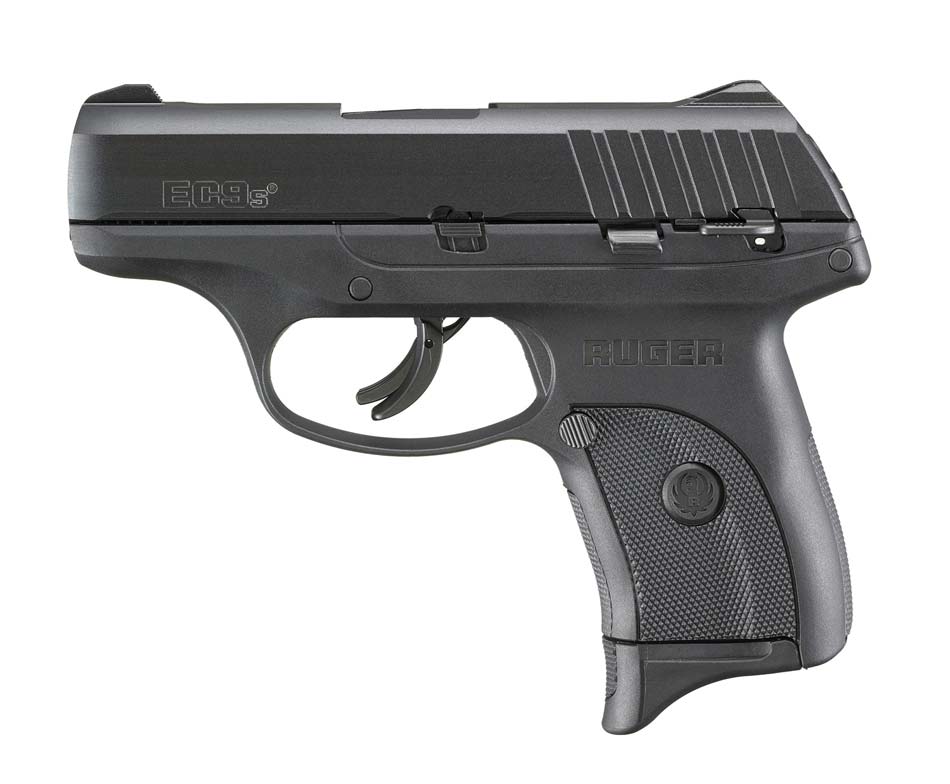
Where to Buy the Ruger EC9s
The EC9s is an incredible value. You can purchase this gun online through the affiliate links below and pick it up at your local gun shop.
- Sportsman’s Guide (best price and no-interest payments)
- Palmetto State Armory
- Guns.com
- Sportsman’s Warehouse
Introduction of the EC9s
Days ahead of the 2018 SHOT Show, Ruger announced a new handgun aimed at being an affordable self-defense pistol: the EC9s.
The Ruger EC9s was a new model, but one that design cues from the company’s existing LC9s. The two guns shared many features and were the same size.
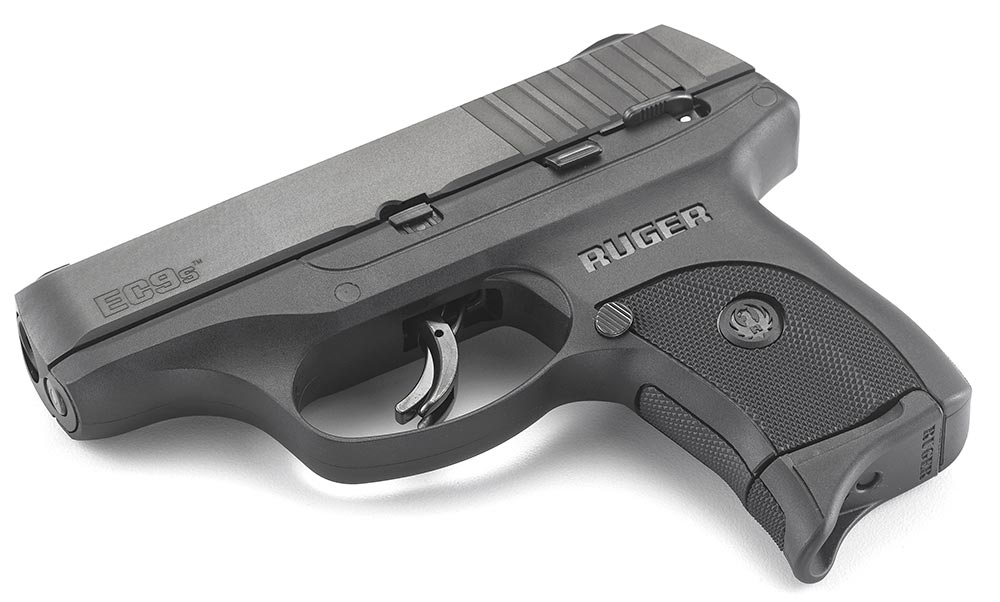
However, the EC9s was significantly more affordable with a suggested retail price that was nearly $200 cheaper. As you might expect, people flocked to the less expensive gun. Eventually, Ruger discontinued the LC9s.
In the years since its introduction, the EC9s proved to be a reliable performer. Some early adopters reported issues with the striker mechanism, but those complaints fell away and the company seems to have fixed any problems in the production line.
EC9s Features
Sized for concealed carry, the EC9s is chambered for the 9mm cartridge. The 9mm is a proven defensive round, and when you select high-performance ammunition, it will perform admirably for you. Let’s review some of the additional features that make this gun a good consideration for CCW.
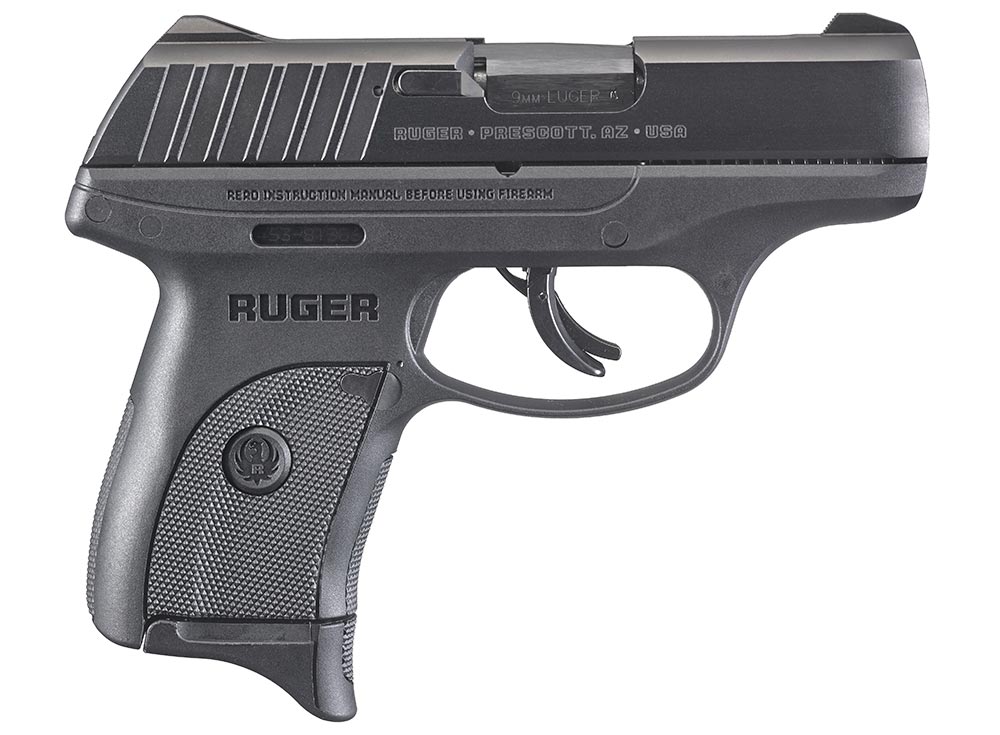
The EC9s feeds from the same 7-round magazines that run in the LC9s. This can work to your benefit as mags marked for the discontinued LC9s might be found at a bargain price.
It has a 3.12″ barrel and weighs about 17 ounces unloaded. It is relatively compact with a height of 4.5″. Its thinness – only 0.9″ – should help it to conceal as easily as the LC9s did.
This is a striker-fired pistol. As with many striker-fired handguns, Ruger added a pivoting safety lever in the center of the trigger. This helps to prevent accidental discharges when the handgun is dropped.
Like many of Ruger’s pistols, this gun has a small thumb safety on the left side of the frame. While many people do not see the need for an external safety, many of Ruger’s customers appear to appreciate this option.
One of the cost-saving measures used by the company is to use sights that are integral to the slide instead of replaceable sights that are dovetailed into place. Both the front and rear sights have serrations on their faces to reduce glare when shooting in bright light.
Another cost-saving decision made by the company was the inclusion of only one magazine. I always recommend having several magazines for each firearm you own as they tend to be the most likely point of failure in a gun. At least Ruger includes a pinky extension for the magazine floorplate.
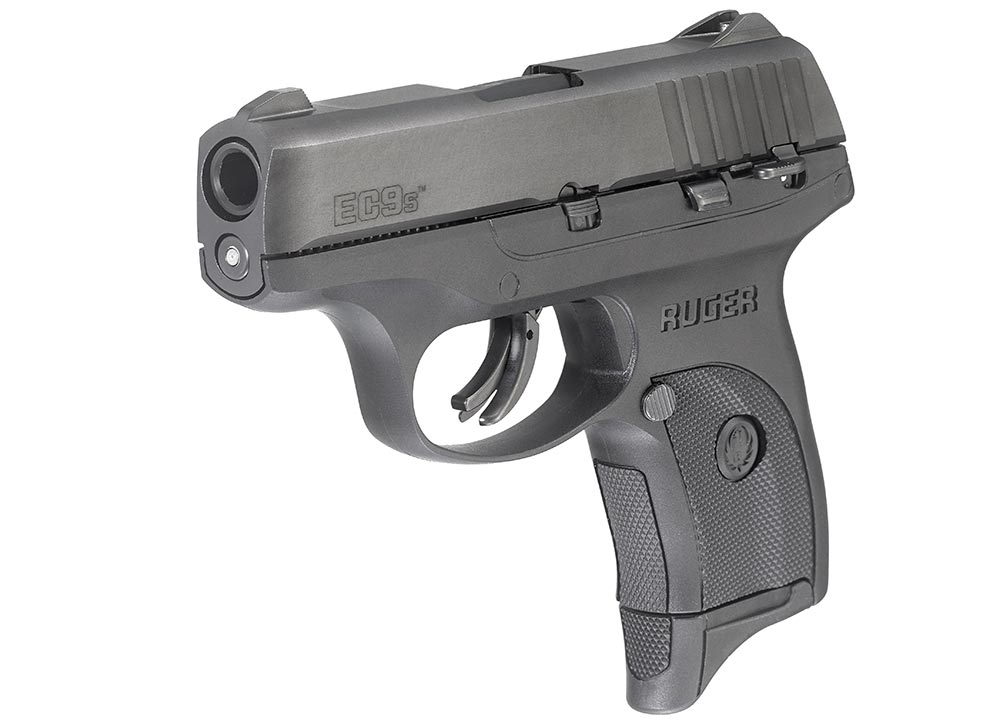
Originally, Ruger set the suggested retail price on these pistols at $299. After more than 5 years, Ruger continues to keep the price low on these guns. Currently, the suggested retail price is only $339.
Since dealers often sell Ruger products below full retail, it is conceivable that you could walk out of the local gun shop with one of these for less than $300 total with tax, transfer fees, etc.
All of the links above are to dealers with prices well under $300.
Ruger EC9s Specifications
Here are the specifications on the base model EC9s:
| Model # | 3283 |
| Caliber | 9mm |
| Magazine Capacity | 7 rounds |
| Included Magazines | one |
| Barrel Length | 3.12″ |
| Overall Length | 6.0″ |
| Width | 0.9″ |
| Finish | black oxide |
| MSRP – at launch | $299 |
| MSRP – current | $339 |
EC9s Variants
With a gun this popular, it is understandable that Ruger would want to offer variations to appeal to as many different shooters as possible.
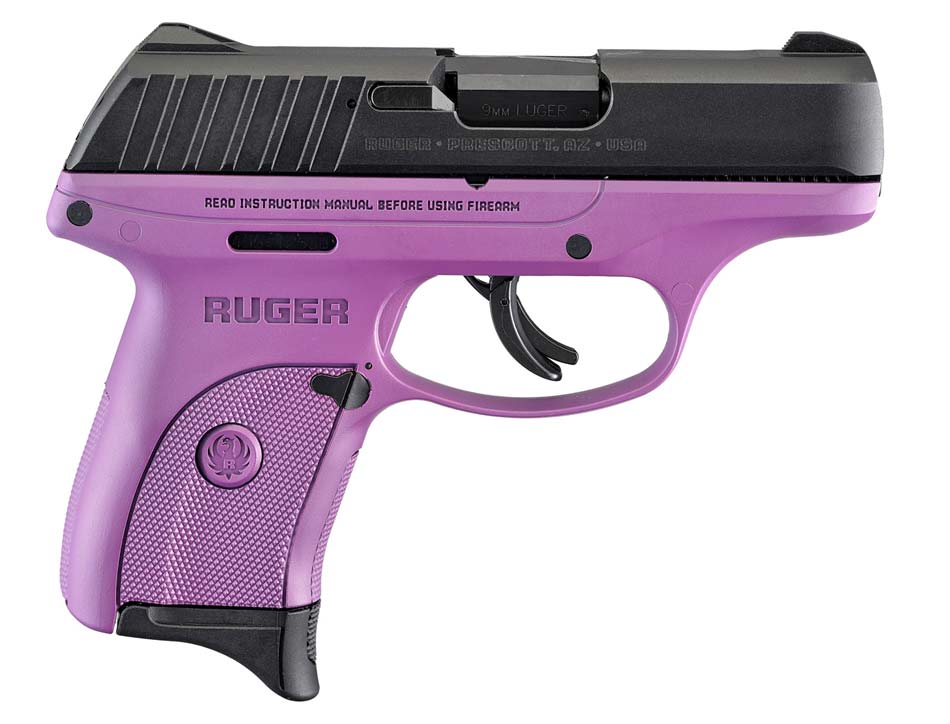
Ruger offers the EC9s in a rainbow of colors including those with purple, turquoise, gray, FDE and Muddy Girl colors. You can see the full line of EC9s color options through this affiliate link and this one.
Last Update: July 2, 2022
89 replies on “Ruger EC9s – Inexpensive 9mm for Concealed Carry”
How about coming out with a high-capacity version that weighs the same as a Kel-Tec P11?
They would probably sell a boatload of them.
Earlier this year I wrote to Ruger asking them the same question. I suggested that their LC9s with the hi viz sights would be the best candidate for this upgrade. I made a similar suggestion to Kel-Tec that they upgrade their trigger system and sights. All I’ve heard since then are crickets.
Even worse is if you ask Ruger any ammo questions that pertains to their guns all you get back is you need to try them out for yourself and if you ask the ammo makers they say talk to the manufacturer. It was pertaining to the lcp and the use of hst ammo being safe for the pistol and Ruger couldn’t answer the simple question. They just care about money these days it keeps seeming like.
Mitch,
You could always try firing some HST in it and if it blows up, use your previous email exchange with them n your lawsuit (just kidding). I rarely use high pressure ammo in non-magnum guns. It never does them any good and I find my reaction time between shots is slower. I believe proper bullet placement and penetration are the most critical factors. The former is very difficult to control in a gunfight where your target is moving around and shooting back at you, while the latter has more to do with bullet weight and design, rather than velocity. Almost any RN FMJ or RN lead projectile provides good penetration, but flat tip versions of either one tend to hit harder and do more damage without the need for expansion. Also, the heavier the bullet, the better. It’s old school thinking but it works without resorting to high pressure loads and controlled expansion rounds. I’m not knocking these. When they work, they tend to work great, but they don’t always work as designed.
I agree about placement but when a company who makes firearms can’t tell you if 99 grains is safe for a micro gun theirs a major issue. The lcp doesn’t do plus p ammo but their response was just silly and ridiculous. I usually go 90 grain ammo like umc blunt nose that my lcp feeds beautifully.
There are heavier bullets available for the 380. I think in factory loads they top out around 105 grains. A friend of mine once hand-loaded 124 brain bullets in 380, though I imagine they were moving about as fast as an excited tortoise.
There is NO SAMMI standard for 380 +P ACP ammo, which is why it is not recommended in the LCP. The ‘+P’ is whatever the ammo maker decides on with NO guidelines However, 38 Spl +P, 9mm Luger +P and a couple of others do have SAMMI standards.
Colonel K.,
I am not new to shooting handguns, but I do have a question, and I think you might be able to answer it. With the shorter barrel on this type of a gun, does in make more sense to use a heavier bullet, to help with hitting power, rather than a light bullet, that relies on it going fast to cause destruction?
I know that is a long question, but I hope you can follow it.
I also have as an every day carry gun, my Taurus millenium G2, which is great. Plus I own a 1911, that I will carry on occasion. But I don’t actually have enough rounds through it to decide how it is going to act. So far, not a single hiccup, in over 350 rounds..
Sorry for getting off on a tangent, but I am just starting to think that I should get rid of my 1911, even though it is fun to shoot. I cannot get ammo cheaper than it is right now, for 9mm. And I kind of dislike stocking two different ammo types, even though it is not a big deal. I am just seeing a lot of nice 9mm out there right now, and I would like to try a couple out, and considering carrying one. I am not a thin person, and so the smaller gun would be a good thing for me to carry. Plus, of course, I could keep itin my weak side pocket as a back up my main gun.
Anyway, after all this rambling, I juts want to say thank you for a very good website. I think this is my first visit, but it won’t be the last. You people are rocking the gun scene very well.
Tim, that is a question without a definitive answer. Any bullet that penetrates deeply and disrupts a vital organ, nerve, or blood vessel is a potentially lethal bullet. In theory, the bigger the frontal area is and/or the faster the projectile travels, the larger the wound path will be, so the greater the likelihood it will prove decisive (stop/kill your opponent). Mass can mean one bullet or several bullets fired in succession. For practical reasons, we should consider only the single bullet theory, and herein lies the problem. The average handgun lacks sufficient power to create a massive wound channel and thus guarantee a very high probability of one-shot stops. The concealed handgun, with its presumably shorter barrel, has even less power, so the problem becomes even more acute. Assuming you want a concealed carry gun that minimizes bulk, weight, recoil, and muzzle bast, the most efficient cartridges I’ve found to date are the 38 Special and the 9mm Para. Whatever ammo you settle on, make sure you first test it for reliability in your firearm. If possible, chronograph it and recover samples from test media to determine its penetration, retained mass, and expansion. Most folks find this level of experimentation to be impractical, so they turn to the internet. Right now I know of two YouTube channels whose experiments are worth consideration (there may be others I have not discovered). I suggest you check out Paul Harrell and Shootingthebull410 (Ammo Quest). I think you will find that some ballistic tipped hollow points work very well, as do flat tipped heavy lead projectiles. Other HP loads can work well if they do not become clogged with bits of clothing. You may also discover that you can fit heavier bullets into revolvers because they aren’t particular about their diet. For the 38, “manstopper” loads up to 200 grains can be found. For the 9mm, factory loaded bullets peak at around 147 grains, though heavier bullets up t o180 grains are theoretically possible.
With regard to handgun selection I always tell my clients and students that firearms are like clothing – buy what you like and feel comfortable with. Also keep in mind that tastes and needs change, as does technology. For decades I carried various 1911 pistols (Llama, Colt, Detoncis,
etc.), but as I aged I determined they were too heavy, complex, or finicky for high pucker factor me-to-you
engagements. I did not feel adequately protected with 380s, 9mm, and 38 snubbies, though I used them as well. But as bullet performance improved and high-capacity, simple-to-operate plasticated pistols entered the market, I took the plunge, eventually settling on the Kel-Tec P11 for its size, weight, firepower, and simplicity. It has its faults – a heavy DAO trigger and spotty reputation, but it remains unchallenged within its special niche. You use the Taurus, which is a gun my brother also prefers. I considered it as well for its handling and firepower, but my experience proved to be disappointing from the start. It was heavier and bulkier than the Kel-Tec P11 and I paid too much for it. To add insult to injury, it arrived with a defective trigger and had to be sent back for repair. When I finally got to shoot it I realized it is not a pistol intended for southpaws, having only a single sided manual safety. I had assumed, incorrectly, it could safely be carried w/o the manual safety engaged. I know many other folks love it and perhaps feel safe toting it with the safety off, but I am too old and too wary for that. I prefer a firearm that I can carry all day safely and rapidly fire without having to do anything other than pull the trigger. For this latter reason I prefer carry guns that lack a manual safety (I’ve had safeties engage and disengage when I didn’t tell them to). I also like lots of bullets. My eyes are not as sharp as in the past, and now I have the added fear of attacks by terrorists (done that) or mass murderers (not yet, hopefully not ever). No, I’m not planning to go “Die Hard” on them. I just want enough firepower to keep them at bay while I execute that famous Monty Python maneuver “RUN AWAY”. Having said all that as a premise, my advice to you is to keep your 1911 if you can afford to do so, but pick up a 9mm you find appealing. I love the Browning Hi Power MKIII, but it is as old school as the 1911 when it comes to concealed carry. But both guns make excellent field carry firearms. For concealed carry I would take a hard look at the new Sig 365. It’s the gun I had hoped the G2 would be. The trigger is great, and the only complaints I have about it are the weight and the fact that Sig introduced it before it was ready for prime time. Supposedly the latter issue has been fixed, but I’m still concerned about the weight. It’s really not all that heavy, but the difference between it and the P11 is noticeable, and that remains my frame of reference. I hope my comments are of some help.
Thank you for your response, sir. If everything was equal, I would choose the CZ 2075 Rami. My son has one, and I love it. But they are just a little over what I want to pay for my carry gun. I love the traditional double action in a semi auto pistol, and even though there are a lot of armchair quarterbacks who love to debate calibers, I think that the 9mm from a reputable company, using modern technology is probably just as effective as .45 ACP. I have also seen several other companies making a good 9mm traditional double action, with a hammer and a hammer drop plus a safety. That gives one a choice of carrying with a safety on or off, with no real danger either way.
I know also that many people love their Glocks, but I am old, and simply cannot get over the lack of a manual safety, combined with a fairly light trigger pull. And yes, I know that hundreds of thousands of people carry them, with no issues. It is just a mental block with me.
Again, thanks for your quick response, and I will take your advice and might end up selling my 1911, just to afford a better 9mm carry gun. I always hate to do so, but I am a debt free person, who will never go into debt again, and so I can’t afford a grand for a nice Kimber or Sig.
If there’s one nearby, you might try visiting a well stocked gun store. A knowledgeable sales clerk is helpful but not necessary. Simply ask to sample the feel and handling of a wide variety of 9mm pistols. Since dealing with two different trigger pulls (DA and SA) doesn’t bother you, there are a lot firearms, both new and used, to choose from. Weight and size may be your only issues. The closets thing I know of that is similar to the CZ 2075 Rami is the somewhat larger TriStar Canik 55 C-100. It’s an affordable compact CZ clone weighing 26 oz empty and retailing in the $350 -$400 range. Occasionally you can find used compact CZ75 and CZ85 pistols for sale on Gun Broker. Ruger, S&W, Taurus, and Bersa also make some affordable 9mm compacts with manual safeties or decockers for DA/SA carry. I particularly like the safety setup on the Taurus PT99, 917 Compact, 809, and new TH9 pistols. You can carry them cocked and locked like a 1911 or you can push the thumb safety down past the fire position and it will act as a decocker by safely lowering the hammer for traditional DA/SA carry. Some of these pistols are out of production but available on the aftermarket.
I have owned 3 10/22’s and they each “liked” different brands of ammo. One was a tack driver with yellow jackets and another grouped at a foot at 100 yards! I took them to the range together and there was an unbelievable difference.
A second magazine would have been nice, but I know they did it to get the asking price below $300. Mentally, that’s a big deal for shoppers.
They only include 1 mag with the LC9S, so they are just continuing to be cheap in that regard.
i can get the better lc9s for 259.00 now- why these are made cheap
who’s got it for that price??
Where? I’d like in on that deal!